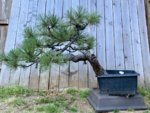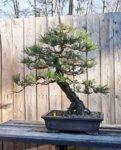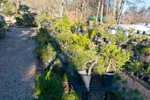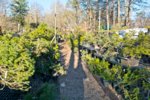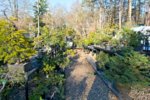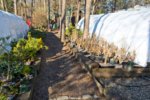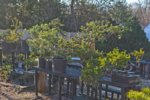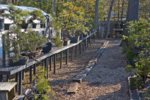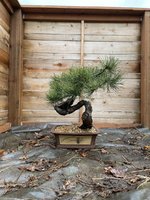I want to be clear I’m very open to thoughts and input on this tree. Of the things I do in bonsai, my experience with Rocky Mountain Ponderosa is low (I have some Willamette Ponderosa) and with yamadori my experience is middling (but conceptual knowledge is medium-high).
The trunk of this tree is interesting. Only from this front do we see the widest base and the deadwood at the same time. That’s one constraint.
The deadwood is around where the tree has circled back a little bit from injuries. This is somewhat inverse taper but especially a big visual weight of closed space. I know yamadori are given some excuse for “defects” and so I think there’s no big problem here. (I’ll just recognize this tree is interesting but not world class.
What
feels right (maybe familiar??) would be to set a guy wire (blue) to compact the tree, close that space a little, and to somewhat hide the imbalance of weight between the base, middle trunk, and deadwood area. The red lines show how the trunk would move.

Some BSOP members and Mirai students who have seen this tree in person were really wanting it to become a cascade. I’m not quite sure why I feel hesitant to do that.
Maybe where I’m landing is this conundrum: the trunk is dancing around and lively (which I love) but the main branching is quite compact and doesn’t seem like it could “carry” the design of this tree as expansive and fluid. The root ball and trunk just seem to work as a cascade and I think the foliage would nicely continue the aesthetic. As a cascade design the placement of the foliage seems like it would work quite well from a horticulture stance, too: nothing would be too low and shaded out.
So did I just answer my own problem? I suspect I might need to wait to pick a style until the foliage is absolutely cranking out new buds and branches.


